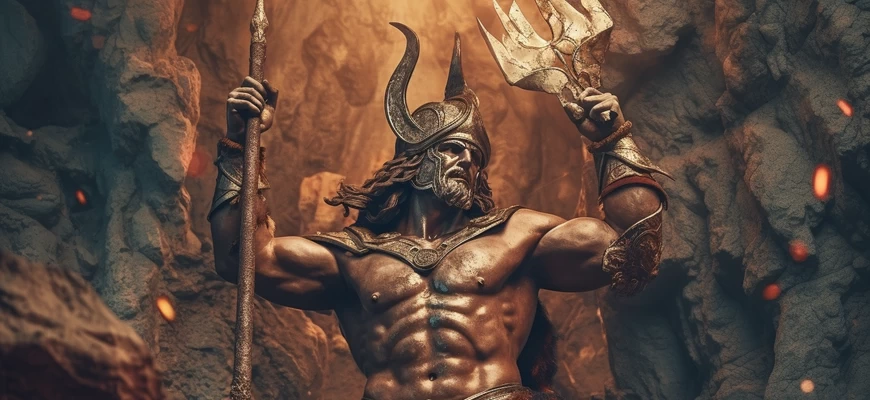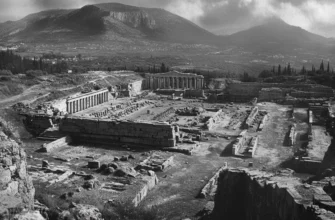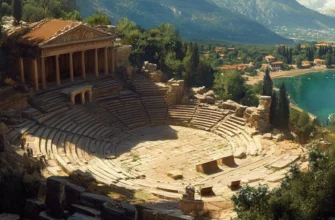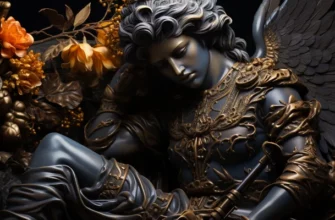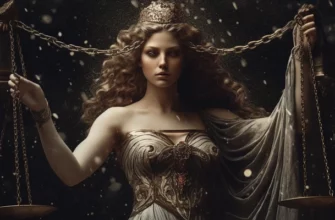Ares is the god of war and violence in Greek mythology. He was often depicted with weapons and a shield, and his symbols were roosters and dogs. Ares had a complex character, which was reflected in his various aspects. He was a symbol of military courage and fighting spirit, but was also considered a deity who brought suffering and chaos. In the religious life of the Greeks, Ares played an important role, and his cult was popular in many cities of Greece. Today, the image of Ares continues to intrigue people as he is portrayed in literature, art, and film.
- Characteristics of Ares
- Description of appearance and symbolism
- Character and characteristics of the god
- Ares’ place in the Greek mythological pantheon
- Origin and family of the god
- The story of Ares and his cult
- Myths and legends associated with Ares
- The role of the god in the life of the Greeks
- The cult of Ares and religious rituals
- Depictions of Ares in culture and art
- Conclusion
Characteristics of Ares
Ares is the god of war and violence in Greek mythology, who had a complex character. Ares was depicted wearing military clothing and carrying weapons such as a shield and sword, and his symbols were roosters and dogs. In legends, Ares is known as the god of war, leading the battle lines and helping to defeat the enemy. However, he also represented strength, violence, and bloodshed, making him a symbol of suffering and chaos. Ares had weaknesses, such as being easily wounded and suffering frequent failures, which reinforced his unstable character. In Greek mythology, Ares is also known as the god of fear, who was able to win by intimidating his enemies. Overall, Ares had a complex character with both positive and negative aspects.
Description of appearance and symbolism
Ares is the god of war and violence in Greek mythology, whose appearance was depicted in military clothing and weapons. He was usually depicted in armor consisting of brass or iron scales, as well as a shield and sword. His symbols were roosters, dogs, and wolves, which were associated with war and fighting spirit. Ares was also characterized by a golden bracelet on his leg, which symbolized his masculinity and fighting spirit. In some depictions of Ares, he may have wings, which added elements of heavenly power and invincibility. Overall, Ares’ appearance and symbolism reflect his power over war and violence, as well as his masculinity and fighting spirit.
Character and characteristics of the god
In Greek mythology, Ares is known as the god of war and violence. Although he had a complex character, his main traits were strength, masculinity, and fighting spirit. Ares represented strength and power over war, helping to defeat enemies. However, he also represented bloodshed, violence, and suffering, which made him a symbol of chaos and instability. Although Ares had weaknesses, such as frequent failures and easy injury, he was feared as a god of fear, intimidating enemies and causing them to panic. Overall, Ares’ characteristics reflect his spirit of war and violence, which played an important role in Greek mythology.
Ares’ place in the Greek mythological pantheon
In Greek mythology, Ares was one of the main Olympian gods. He was the son of Zeus and Hera, making him the brother of many other gods and goddesses. Although Ares was less respected than his siblings, such as Athena, Apollo, and Hercules, he was still an important figure in Greek mythology. Ares was often depicted alongside other war gods, such as Athena and Artemis, reflecting their power over war and protection. According to legend, Ares was also involved in many wars and conflicts between gods and humans, so he was often associated with violence and bloodshed. Overall, Ares held an important place in Greek mythology, was an integral part of the Greek pantheon, and played an important role in the wars and conflicts that took place in the mythical world.
Origin and family of the god
In Greek mythology, Ares was the son of Zeus and Hera. According to legend, Hera was jealous of Zeus’s lover Io, so she decided to take revenge by giving birth to Ares, who was known for his cruelty and violence. Ares had numerous children, including Phobos, Eros, Antiochus, Demos, Phobos, and Harmonia. He also had many mistresses, including Aphrodite, Eris, and Athena. In Greek mythology, Ares was often depicted as one of the main military gods, involved in warfare and conflicts between gods and humans. His family and origins were important parts of Greek mythology, reflecting his power and influence over the lives of gods and humans.
The story of Ares and his cult
Ares played an important role in Greek mythology as the god of war and violence, as well as a symbol of masculinity and bravery. His cult was widespread in Ancient Greece, particularly in Sparta, where he was often honored in military ceremonies and rituals. Ares was often depicted in various forms, including as a warrior with weapons and a shield, or on horseback.
In some myths, Ares was portrayed as a deity who did not always have the support of other gods, particularly the goddess of wisdom, Athena, who disliked violence and war. Ares also had several enemies among the gods, including Apollo, the god of art and music, who opposed his cruelty and violence.
Despite his significant role in Greek mythology, the cult of Ares was not as popular as the cult of other gods, such as Zeus, Poseidon, and Apollo. Also, due to his character, Ares was not always known for his wisdom and high moral behavior, which made him less popular among the people. However, he continued to be of great importance as a symbol of war and bravery, and his story and cult continue to be important elements of Greek mythology.
Myths and legends associated with Ares
Ares was an important figure in many myths and legends of ancient Greek mythology. One of the most famous myths associated with Ares is the story of his love affair with Aphrodite, the goddess of beauty and love. According to legend, Aphrodite betrayed her husband Hephaestus with Ares, and they kept their meetings secret. One day, Hephaestus noticed them and told the other gods. As a result, Ares and Aphrodite were exposed and expelled from Olympus.
In another myth associated with Ares, his brave actions on the battlefield helped the gods defeat the giant Aloy. According to another legend, Ares was wounded by the hero Diomedes on the battlefield and had to flee to Olympus to see a doctor to heal his wounds.
Ares also played an important role in myths about the creation of cities and states, as his cult was widespread in the military world. Ares was also an important symbol in art, especially in ancient military rituals and ceremonies.
All these myths and legends helped create many images and symbols associated with Ares and demonstrated his important place in Greek mythology.
The role of the god in the life of the Greeks
Ares played an important role in the lives of the ancient Greeks as he was the god of war and violence. The Greeks often turned to Ares for help in battle, and he was called upon to ensure their victory. In ancient Greece, there were many temples and shrines dedicated to Ares, where various rituals and ceremonies were performed to attract his support.
However, Ares was also the god of violence and aggression, and many Greeks viewed him with a certain degree of hostility. They believed that his influence on people could be negative and feared that his cult could lead to armed conflicts and wars.
Nevertheless, Ares played an important role in ancient Greek traditions and culture, and his symbolism became an integral part of art and literature. His image changed depending on the era and region, but he always remained recognized as an important god in Greek mythology.
The cult of Ares and religious rituals
The cult of Ares was widespread in ancient Greece, especially among the military classes. Many cities had temples and shrines dedicated to Ares, where religious rituals and sacrifices were performed. The god was often depicted in armor, with a helmet and shield, and with weapons in his hands.
One of the most important rituals associated with the cult of Ares was the “apella,” a gathering of citizens where they discussed issues related to war and the safety of the city. At this time, religious rituals dedicated to Ares were also held, where the god was called upon to protect the city and ensure its victory in wars.
In addition, Ares was also revered as a god of strength and courage, and he was often involved in sporting competitions. Participants in competitions often prayed to him for strength and victory.
The temples of Ares were also places of refuge for criminals and refugees who could hope for the god’s protection from persecution.
All of these religious rituals and connections to the cult of Ares reflected the importance that this god had in the lives of the ancient Greeks as a symbol of war, violence, and strength.
Depictions of Ares in culture and art
Ares was an important theme in Greek art and culture. He was often depicted on vases, reliefs, and statues. He was usually depicted in armor, with a shield and sword, or on horseback with weapons in his hands.
In Greek myths and legends, Ares was often mentioned as a hero or villain, but he was also depicted as a god who could grant military advantage. In the plays of Sophocles and Euripides, Ares was often used as a symbol of war and violence, as well as a character who could intervene in people’s lives.
In modern culture, Ares is also often mentioned as a symbol of war and violence. He appears in books, movies, and video games, where he is usually depicted as a strong and ruthless warrior.
Conclusion
Ares – ancient Greek god of war, violence, and bloodshed. He was the personification of cruel, ruthless, and brutal force that ruled over the people who lived in times of war. Although Ares was not always respected and revered, he was of great importance in Greek mythology and culture, and his image is reflected in many aspects of modern life.
Today, Ares can be seen as a symbol of war and violence. His image is used in culture and art to represent strength and brutality. Ares can also be seen as an allegory for various aspects of human behavior, such as aggression, conflict, and crime. Despite his negative image, Ares can also symbolize the importance of fighting for justice and defending one’s beliefs. Overall, Ares is an important part of cultural heritage that continues to influence modern society.
